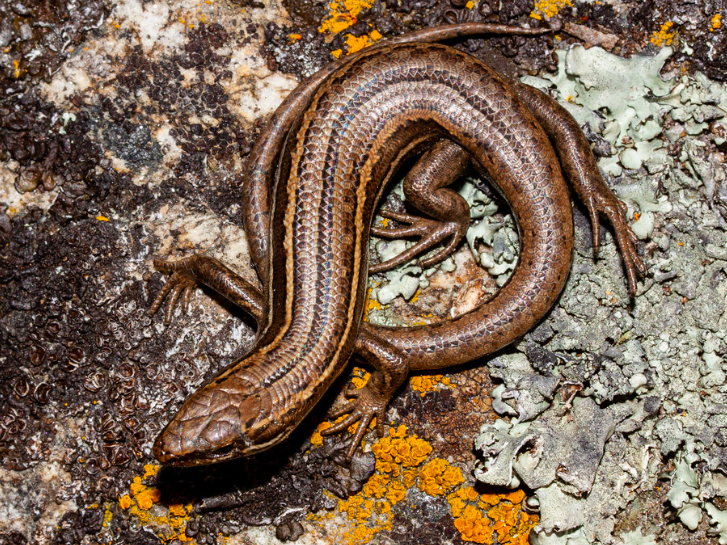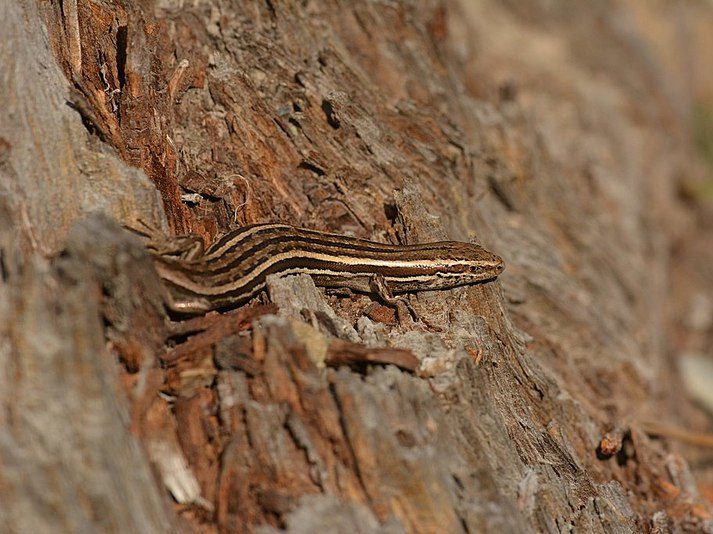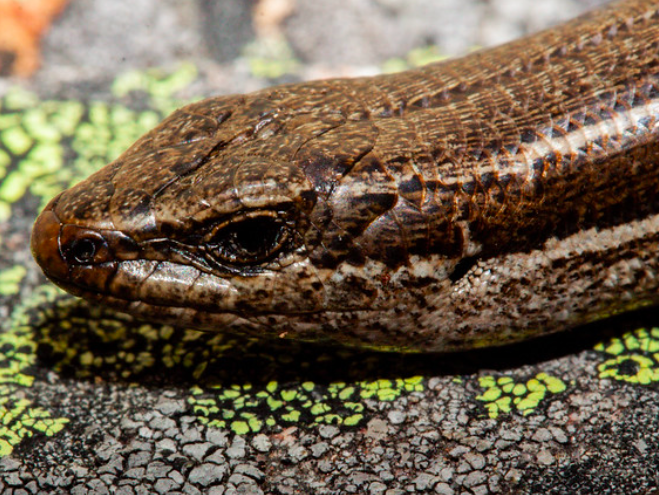When four-legged predators first arrived in Aotearoa New Zealand, the native wildlife didn’t know what had hit them. That was over 200 years ago. Now there’s growing evidence that at least some of our wildlife are wising up to mammalian predators and changing their behaviour accordingly.

So far, most of the research has been about birds, for example it was discovered pīwakawaka (fantails) will nest on the flimsiest of branches where heavier mammals are less likely to venture. But what about our equally vulnerable and very unique skinks and geckos? Are they developing new survival skills too?

Research just published in the Journal of Austral Ecology suggests that some skinks at least, are taking steps to protect themselves when they suspect a predator might be around. But such changes in behaviour also come at a cost. Hiding from your enemy isn’t ideal when you’re a cold-blooded reptile that benefits from basking in the sun. The ability to learn and change does, however, offer hope for our once-naïve wildlife, as the authors explain.
“The impacts of introduced predators are especially clear for island systems and are generally attributed to prey naivete, whereby prey fail to mount effective antipredator responses. Given sufficient experience of predators, prey populations can acquire responses that may allow them to coexist with once-novel predators,” write the authors.
So, the first step is learning to recognise a new predator as a threat.
“Predator recognition can be assessed by testing the ability of prey to discriminate a predator cue from a non-predator cue. The rate at which antipredator behaviours develop depends on factors including the intensity of predation, the type of predator cue (e.g. visual/olfactory/auditory), the fitness costs associated with expression of antipredator traits, the heritability of specific antipredator traits and their genetic architecture, and the cognitive capacity of prey.”
Before humans arrived, the only mammals that our lizards encountered were three species of insect-eating bats – competitors for food perhaps, but not a physical threat to a gecko or skink.
“While there is fossil evidence of other mammal species, including at least one mammal likely to have consumed small vertebrate prey, these species are likely to have been extinct for at least several million years. Therefore, New Zealand lizards lacked experience with mammalian predators before several were introduced with two distinct waves of human colonization (Polynesians c. 1280 AD and Europeans c. 1800 AD). Introduced predators of lizards include cats, ferrets, stoats, weasels, rats, mice and hedgehogs.”
Lizards were, of course, preyed on by some birds so they are well-adapted to avoid danger from vision-based hunters in the air. Their camouflage defences are impressive. But mammals often hunt by scent. Suddenly their reptilian world was a much more dangerous place.
So, how far have they come in the last century or so? What’s changed? What might lizards have learned – and how do scientists go about finding out?
“We aimed to establish whether New Zealand native lizards can recognize and respond to novel predator cues, and to assess the time scales over which antipredator responses can change. We measured the behaviour of two populations of McCann’s skink (Oligosoma maccanni) in response to different predation risk scenarios (treatments). Treatments included the presentation of whole-body cues from an introduced predator (a live feral cat), visual cues of a coevolved predator (a model raptor) and an introduced predator’s olfactory cue (cat scent).”
Skink populations were sourced from an area of high mammalian predator density, and from within a conservation fence where mammalian predators have been absent for 3–4 skink generations. Both skink populations were used to co-existing with native and introduced bird predators.
“McCann’s skink is a relatively common and widespread species listed as ‘non-threatened’ under the NZTCS, which has persisted in areas with large and diverse predator populations. They are nonetheless found in nearly 60% of feral cat scats, with scats containing up to 45 individual lizards. It is therefore an ideal species to test whether any of New Zealand’s lizards have moved beyond Level 1 naivete to mammalian predators.”
The researchers hoped their research project would answer 3 key questions:
- Can McCann’s skinks discriminate cues of an introduced mammalian predator, the feral cat, from procedural control cues?
- Has the removal of introduced mammalian predators from a fenced reserve diminished the response of McCann’s skinks to predation risk?
- Do McCann’s skinks balance the fitness benefits of predator avoidance against associated costs?
“To answer these questions, we examined skinks’ basking behaviour because basking exposes them to greater predation risk. Because maximizing basking opportunities has direct links to increased fitness, we predict that skinks will be able to discriminate and interpret predator cues to minimize risk by basking less frequently and/or in safer sites (i.e. closer to refuge).
“We also predict that while both populations would demonstrate a similar antipredator response to a raptor cue (a coevolved and ubiquitous threat), the population currently without mammalian predators would have a weaker antipredator response to cat cues than the skinks from the high-predator population, and that basking would be concentrated during the safest periods of each treatment day.”
The skinks were collected from two populations near Macraes Flat in eastern Otago.
“Skinks from the ‘low-predator population’ were sourced from a fenced reserve which has been free of all mammalian predators (excluding occasional incursions of house mice) since August 2006. Skinks from the ‘high-predator population’ came from ‘Golden Point’, a 20-hectare reserve located 11 kilometres north of the fenced population; with no formal predator control where skinks coexist with six potential predators—cats, ferrets, stoat, hedgehogs, Norway rats and house mice—as confirmed by a camera survey conducted at the time of skink collection (99 trap nights).”
Introduced herbivores – rabbits, red deer and feral pigs – are also present in the area and there are plenty of potential avian predators including kahu (Australasian harriers), kārearea (New Zealand falcons) and introduced Australian magpies, tāringi (common starlings) and ruru nohinohi (little owls).

The research team collected 32 adult skinks (16 males and 16 females) from each population in January 2018 using pitfall traps.
“All skinks were likely to be at least two years old, based on the seasonality of births and the presence of smaller size classes. Captured skinks were transported to the laboratory for acclimation and behavioural testing and released at site of capture on completion of the study. The study took place after females had given birth, but during male spermiogenesis when basking is a key requirement. Given that reducing basking has high fitness costs, we predicted that male skinks would bask more frequently than female skinks.”
Each skink was housed in a 60-L clear plastic terrarium, with a 5 cm deep sand/pebble substrate (builders pre-mix). They had a warm retreat/basking site (terracotta saucer, 11 cm diameter), situated 20 cm directly beneath a 42 W halogen lamp, a cool retreat site and an area of vegetative cover (moss).
“Skinks were fed every 2–3 days on a combination of cut fruit (apricot/mango), pureed fruit mixed with protein powder and mealworms dusted in calcium powder. Skinks were then exposed to one of the four following treatments each day over successive days: (a) procedural controls only [empty cage, unscented towel and activated pulley], (b) cat scent, (c) a caged live female feral cat and (d) a taxidermy harrier in flight.”
The ‘raptor treatment’ consisted of a taxidermy Australasian Harrier mounted in an attacking position which was attached to a pulley system and ‘flown’ across the arena.
Predator recognition was inferred from reductions in individual basking and higher selection for basking sites with greater refuge availability.
“Skinks were recorded basking 19.4% of the time (32 518 out of 167 610 images) for a mean of 128 min/day (range 0–349 min). On average skinks basked at high-refuge sites 80% of the time (n = 190, range = 36– 100%). The number of individuals that consistently basked above the 128 min/day average was skewed towards the low-predator population (15 of 19 individuals) and towards males (14 of 19 individuals).”
“Population and sex had a relatively large effect on basking that was consistent across all treatments and all periods. Male skinks consistently basked more often than females (mean difference 62 min/day), and skinks sourced from the low-predator population basked more than skinks from the high-predator population (mean difference 68 min/day).”
As predicted, skinks altered their basking in response to predator cues and this response differed between the two populations that the skinks were sourced from.
“During the cat exposure period, skinks from the high-predator population reduced basking in the presence of a live cat (2.76 times less likely to bask) or cat scent with an empty cat cage (2.29 times less likely to bask), relative to the procedural control, but skinks from the low-predator population did not. Similarly, during the raptor exposure period, only skinks from the high-predator population reduced basking when exposed to a raptor cue (8.40 times less likely to bask) or to cat scent with the raptor pulley activated without the raptor (3.65 times less likely to bask), relative to the procedural control.”
So exposing skinks from the high-predator population to a live cat, and to cat scent alone, resulted in temporary reductions in basking.
“This suggests that for at least one species of New Zealand lizard, the period of exposure to a novel predator has been sufficient for the development of cue discrimination and an adaptive behavioural response. Feral cats are unlikely to have become established in the study area before the establishment of rabbits, approximately 150 years ago; therefore, these adaptations have developed within a maximum of 50 skink generations.”
The skinks responded more to visual cues of predators than just to predator scent.
“We found stronger evidence of an antipredator response when visual cues of predators —a live cat and a model raptor—were presented than when lizards were exposed to chemical cues alone (although a direct comparison is difficult due to differences in the duration of exposure to each cue type). This supports previous suggestions that New Zealand lizards may rely heavily on non-chemical cues (e.g. visual, auditory) to detect and respond to predators.”
“We compared skink responses only to procedural controls (i.e. empty cage, unscented towel and activated pulley), not to a novel scent, organism or object. Therefore, we were unable to tell whether skinks were responding to the cat, cat scent or raptor specifically, or just to the presence of a novel stimulus. Nevertheless, skinks from the high-predator population appeared to be more vigilant, in general, and thus may have been responding to any cue that indicated potential danger.”
But it seems that lessons learned over 50 generations might be forgotten in as little as 3-4 generations.
“While the high-predator population temporarily reduced basking in the presence of a live cat, cat scent or a model raptor, the low-predator population did not reduce basking in the presence of any of these potential threats. This suggests that removal of mammalian predators has led to the loss of cat and raptor recognition within 3–4 skink generations. While lack of replication in our study meant that predator effects could not be separated from location effects, the results concur with the well-documented loss of predator recognition and antipredator behaviour following release from predation pressure in reptiles and other taxa.”
According to the authors, loss of predator recognition behaviours often occurs very rapidly because in lower-risk environments, excessive predator avoidance (e.g. not basking) can have strong fitness costs. Natural selection can work to limit the retention of these behaviours.
“The recent removal of mammalian predators appears to have diminished not only the response by skinks to the risk posed by cats, but also to avian predators. This was an unexpected result, given that skinks from the low-predator population coevolved with avian predators and continue to live in an area accessible to avian predators.”
Do McCann’s skinks balance the fitness benefits of predator avoidance against other survival costs?
“Basking is tightly coupled with fitness in lizards particularly for viviparous species in colder climates. To maximize fitness, lizards must balance avoiding predation with performing behaviours that maintain metabolism, such as basking. This balance will change with predation risk. In the low-predator population, the high cost of reducing basking for this temperate, viviparous species may have favoured individuals that bask more frequently regardless of predator cues. As basking behaviour is closely associated with fitness, it should be particularly sensitive to changes in predation pressure. This means that reductions in basking may have been lost rapidly with predator reductions, while other antipredator behaviours may not have changed at the same rate.”
Then there is the observed difference in basking between the male and female skinks.
“Male skinks consistently basked more frequently than female skinks, regardless of population or treatment, presumably to maximize spermiogenesis. We would predict that females would be less willing to trade off less basking time under heightened predation risk at a different time of year, because of the metabolic costs of pregnancy.”

So might all our lizard species be learning to recognise mammal predators? Or does the fact that McCann’s Skink isn’t endangered indicate that it is a faster learner than most?
“Differences in predator recognition abilities between prey species may provide a mechanistic hypothesis for patterns of species persistence and vulnerability. By conducting similar studies on a wider range of species that have different susceptibilities to predation, we may be able to determine the extent to which cue recognition contributes to the resilience of prey species in invaded systems. Therefore, the range of native species tested for acquisition of antipredator responses to introduced predators, and the range of cues tested, need to increase.”
Finally, although McCann’s Skink may be able to recognise cats as a threat, that doesn’t mean they are no longer vulnerable to cat predation. The possibility that sanctuary-raised skinks can lose those recognition skills within a few generations also has worrying implications – especially for captive-bred release projects.
“The rapid loss of discrimination of both novel and coevolved predators in skinks from a population not exposed to mammalian predators indicates that predator removal can increase prey naivete and render prey populations vulnerable once again to future increases in predation pressure. This means that predator incursions could be particularly damaging for prey populations exposed to few predators, highlighting the ongoing need for vigilant quarantine practices and fence maintenance. It also highlights the risk of sourcing populations from predator-free islands or fenced sanctuaries for reintroductions into areas with higher predation pressure, at least in the short-term.”
The full research paper is published in ‘Austral Ecology’ and is freely available online.
Rapid gain and loss of predator recognition by an evolutionarily naïve lizard (2022)
Austral Ecology: doi:10.1111/aec.13148

